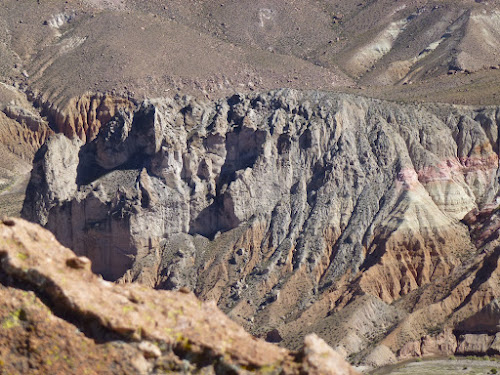Dear everybody
My trip is slowly coming to its end.
From Putre I took the bus to Arica, spent there one night, took the bus to cross the frontier to Peru in Tacna, from there a bus to Arequipa, together about 8,5 hours. Don't ever take busses from the bus company Flores. They have a TV in the bus and played the most horrible movies all the way from Tacna to Arequipa in full volume.
In Arequipa I spent one night at my favorite hotel, the Dreams Hotel ( very recommended), was surprised by a candy box and a piece of birthday cake with a candle on it by the cute hotel receptionist who noticed it was my birthday after making a copy of my passport, paid one last visit to my favorite volcano, the Misti, at mirador Yanahuara, had my clothes washed after 9 days of desert dust and took a flight back to Lima.
For March 28 I had booked 3 months ago a trip on the train, the ferrocarril central andino, from Lima ( at sea level) to Huancayo, almost 3400 meters high.
This train was the highest in the world before they built the pan Himalayan line which climbs 5072 m above sea level in 2005.
the ferrocarril centralandino was built from 1870 until 1909, planned by the polish railway builder Ernest Malinowski and was the brain child of the American entrepeneur American Henry Meiggs who once said: " I can get a train wherever a llama can walk", and so he did. The construction was completed by a multinational team of 10.000 workers, 50% Chinese, 40% Peruvian and 10% Chilean.
Through its journey the train traverses six climatic zones, 68 bridges, 71 tunnels and 9 zigzags. It reaches its highest point at Galera Tunnel 4751 meters, just past the highest passenger train station in the world at Ticlio.
The scenery on the way is amazing. First it goes through a narrow valley with extremely steep high mountains on both sides.
The mountains then change colours from deep purple and pink to black and grey and the snowy tops.
I find the colors so fantastic.
Can you believe this is real?
It is!
God must have been in a specially good mood when he created these mountains.
And towards evening:
The passenger train made its first trip this year on March 28, the next is on May 1. During high season, I think, it goes every 2 weeks. The ferrocarril makes most of its income not from passenger transportation but from the transportation of minerals from the various mines on the way to the shore. It can transport 1200 tons at a time!
We passed several ugly miners towns on the way, the largest of them being La Oroya, with over 30.000 inhabitants. Besides copper, lead and zinc la Oroya produces gold and silver, antimony, bismuth, cadmium, indium, selenium, tellurium, sulphuric acid, arsenic trioxyd etc. and it is one of the top 10 world's worst polluted places!!! You'd never think of that when you pass through this beautiful landscape with the train.
As a result of years of pollution, the hills immediately around the smelter became completely denuded, the river became more toxic and the health of the area inhabitants suffered. Residents have been found to have alarmingly high concentrations of lead in their blood and in the drinking water, and many have bronchial troubles. A 1999 study showed high levels of air pollution, with 85 times more arsenic, 41 times more Cadmium and 13 times more lead than amounts generally considered safe.
When passing through La Oroya and nearby villages you can see many women washing clothes in basins outside their houses, men pulling buckets of water out of the river, people seem to be mostly very poor here. I wonder if they are aware of the dangerous place they live in, I doubt it.
This is the sad side of this beautiful landscape.
The train ride from Lima to Huancayo was supposed to take 12 hours, it took 15 for a distance of about 350 km. I had booked tourist class where the seats look real comfortable but they were not as comfortable as they looked and after 15 hours I decided I'd go back by bus ( only 7,5 hours).
Huancayo is quite an ugly city. After a few hours there I took a bus to the neighbouring villages, had lunch at a pretty lake and decided that one day at this area was enough so I took the 8 am bus back to Lima today and I am really happy to be back here. Another night in Huancayo would have been too much, especially as the cock woke me everyday at 4:30.
Now I'll just enjoy my last 2 days of summer in Lima before heading for one day to New Jersey and then back home.
This is the end of my blog. I hope at least some of you enjoyed it and found some helpful suggestions for your future travels.
And one more advice: If you ever go to Lima, I recommend the Posada do Parque, a really beautiful hotel in a nice quiet neighbourhood, loaded with beautiful artworks, a cosy livingroom, a beautiful diningroom, and all that for 30 dollars a night for a single room with breakfast.
Yours, Ruthie




















































